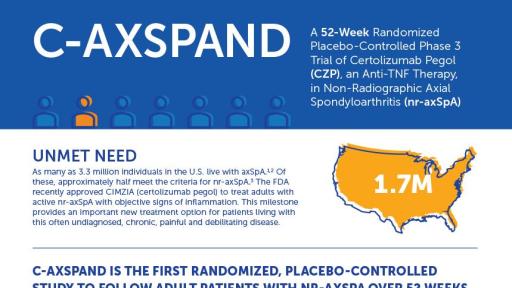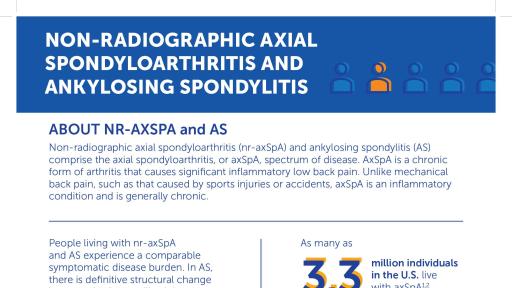CIMZIA® (certolizumab pegol) is Now the First and Only U.S. FDA-Approved Treatment for Non-Radiographic Axial Spondyloarthritis
- Patients living with non-radiographic axial spondyloarthritis, an often undiagnosed, chronic, painful and debilitating disease, now have an approved, clinically validated treatment
- FDA approval was based on the C-AXSPAND Phase 3 study in adults with non-radiographic axial spondyloarthritis, which demonstrated rapid and major improvement response with CIMZIA compared to placebo. Patients remained on common background medications, which could be adjusted at any point during the study
Brussels, Belgium – 28 March 2019 – UCB, a global biopharmaceutical company, announced today that the U.S. Food and Drug Administration (FDA) has approved extending the label for CIMZIA® (certolizumab pegol) to include a new indication for the treatment of adults with active non-radiographic axial spondyloarthritis (nr-axSpA) with objective signs of inflammation. The approval makes CIMZIA the first and only FDA-approved treatment for nr-axSpA.
A chronic inflammatory condition, nr-axSpA mainly affects the spine and sacroiliac joints and is often undiagnosed and not appropriately treated. In nr-axSpA, definitive evidence of the disease is not evident on an x-ray. Disease onset typically begins in early adulthood and causes chronic and debilitating back pain, stiffness and fatigue, often having a profound impact on patients’ lives.
“This is such an important advancement for the spondyloarthritis community. More treatment options, earlier diagnosis, and awareness building will lead to better outcomes for people living with the disease,” said Cassie Shafer, Chief Executive Officer, Spondylitis Association of America.
“The FDA approval of CIMZIA for adults with non-radiographic axial spondyloarthritis will be transformative for the many patients living with this disease,” said Emmanuel Caeymaex, Head of Immunology and Executive Vice President at UCB. “We are proud to be at the forefront of discovering and delivering valuable treatment options for patients with significant disease burden and high unmet need. We are committed to improving care and outcomes for patients across the axial spondyloarthritis spectrum of disease.”
“Non-radiographic axial spondyloarthritis requires early diagnosis, followed by appropriate treatment. Yet for some patients, the journey to diagnosis can take nearly a decade from symptom onset. This FDA indication will make it easier for patients to receive another avenue of treatment in reducing the severe pain, stiffness, and other burdensome symptoms associated with this disease, to help ultimately improve their quality of life,” said Dr. Atul Deodhar, MD, MRCP, FACP, FACR, Professor of Medicine, Oregon Health & Science University, and a lead author for the pivotal C-AXSPAND study.
This FDA approval is based on data from C-AXSPAND, a Phase 3, multi-center, double-blind, placebo-controlled 52-week study that randomized 317 adult patients to receive either CIMZIA or placebo plus common background medications, which included NSAIDs, corticosteroids, analgesics and slow-acting anti-rheumatic drugs.i The study met its primary endpoint, with 47.2% of patients treated with CIMZIA demonstrating major improvement response in Ankylosing Spondylitis Disease Activity Score (ASDAS-MI) at week 52, compared to 7.0% of patients treated with placebo.i ASDAS-MI is a validated, rigorous response threshold, defined as an ASDAS decrease of at least two points from baseline or reaching the lowest possible value.i C-AXSPAND is the first study to adopt this stringent threshold as a primary outcome measure. Detailed findings from the study were published online in Arthritis & Rheumatology on March 8, 2019.
The study also met ASAS40, an important secondary endpoint, with 47.8% of CIMZIA-treated patients achieving a 40% improvement in Ankylosing Spondylitis Assessment Score (ASAS40) compared to 11.4% of placebo-treated patients at week 12.
The safety profile for patients with nr-axSpA treated with CIMZIA was similar to the safety profile seen in patients with RA and previous experience with CIMZIA.
According to the updated label, the recommended dose of CIMZIA for adult patients with nr-axSpA is 400 mg (given as 2 subcutaneous injections of 200 mg each) initially and at weeks 2 and 4, followed by 200 mg every 2 weeks or 400 mg every 4 weeks. For full prescribing information, please visit www.ucb-usa.com.
CIMZIA is also FDA-approved for ankylosing spondylitis (AS), as well as rheumatoid arthritis, psoriatic arthritis, plaque psoriasis, and Crohn’s disease.
About Non-Radiographic Axial Spondyloarthritis (nr-axSpA) and Ankylosing Spondylitis (AS)
nr-axSpA and AS comprise the axial spondyloarthritis, or axSpA, spectrum of disease, which typically starts in patients under 45 years of age. nr-axSpA and AS share similar symptomology and disease burden. In AS there is definitive structural damage in the sacroiliac joints detectable by x-ray. In nr-axSpA, there is no definitive radiographic sacroiliitis, though more sensitive magnetic resonance imaging (MRI) testing may detect evidence of active sacroiliitis, visible as inflammation in the sacroiliac joints. Historically, nr-axSpA has not been well-recognized due to a lack of understanding of the disease history, progression, and prognosis, resulting in substantial diagnostic delay.
Patients face a significant disease burden whether they have nr-axSpA (i.e., no definitive evidence of sacroiliitis on x-ray) or AS (i.e., definitive evidence of sacroiliitis on x-ray). They often experience substantial inflammatory back pain, prolonged and severe stiffness, fatigue, sleep disturbances, reduced physical function, decreased quality of life, impaired work and home productivity and social participation.
Limited evidence exists regarding the exact prevalence of axSpA, though it is thought to impact a substantial proportion of the population. Recent data suggest that 0.5% to 1.4% of the adult population have axSpA, similar to the prevalence of rheumatoid arthritis, which is 0.5% to 1.0%.ii,ii,iv Within the axSpA spectrum of disease, the prevalence is split roughly equally between nr-axSpA and AS.iv
About C-AXSPAND
C-AXSPAND included adult patients with active axSpA without x-ray evidence of ankylosing spondylitis (AS). Patients needed to have objective evidence of inflammatory disease, defined as sacroiliitis on MRI and/or elevated C-reactive protein (CRP) levels. Patients must have had an inadequate response to, have a contraindication to, or have been intolerant to at least two non-steroidal anti-inflammatory drugs (NSAIDs). Inadequate response to an NSAID is defined as lack of response to at least 14 days of continuous NSAID therapy at the highest tolerated dose of the administered NSAID. Patients in both the treatment and placebo groups remained on their background therapy for the duration of the study, which could be adjusted at any point. Safety variables assessed in the study were adverse events, vital signs, physical examination, and measurements of laboratory parameters. The safety profile was consistent with previous clinical trials of CIMZIA.
The primary objective of C-AXSPAND was to assess the safety and efficacy of CIMZIA on the signs and symptoms of active axSpA in patients without x-ray evidence of AS. The primary endpoint assessed was ASDAS-MI response at Week 52. The secondary objectives of the study were to assess efficacy, safety, and tolerability, and to demonstrate the effect of CIMZIA on health outcomes, disease activity, sacroiliac joints, inflammation through MRI, and changes in concomitant and background medications.
The first 52 weeks of the study have been completed and an additional two years of safety follow-up are ongoing.
About CIMZIA® in the US
CIMZIA® is the only Fc-free, PEGylated anti-TNF (Tumor Necrosis Factor). CIMZIA® has a high affinity for human TNF-alpha, selectively neutralizing the pathophysiological effects of TNF-alpha.
CIMZIA® is indicated for the treatment of adults with moderately to severely active rheumatoid arthritis (RA), adults with active psoriatic arthritis (PsA), and adults with active ankylosing spondylitis (AS). CIMZIA is indicated for the treatment of adults with active non-radiographic axial spondyloarthritis (nr-axSpA) with objective signs of inflammation.
CIMZIA® is also indicated for the treatment of moderate to severe plaque psoriasis in adults who are candidates for systemic therapy or phototherapy.
In addition, it is indicated for reducing signs and symptoms of Crohn’s disease (CD) and maintaining clinical response in adult patients with moderately to severely active disease who have had an inadequate response to conventional therapy. See important safety information including risk of serious bacterial, viral and fungal infections and tuberculosis below.
Important Safety Information about CIMZIA® in the US
CONTRAINDICATIONS
CIMZIA is contraindicated in patients with a history of hypersensitivity reaction to certolizumab pegol or to any of the excipients. Reactions have included angioedema, anaphylaxis, serum sickness, and urticaria.
SERIOUS INFECTIONS
Patients treated with CIMZIA are at increased risk for developing serious infections that may lead to hospitalization or death. Most patients who developed these infections were taking concomitant immunosuppressants such as methotrexate or corticosteroids.
Discontinue CIMZIA if a patient develops a serious infection or sepsis.
Reported infections include:
- Active tuberculosis (TB), including reactivation of latent TB. Patients with TB have frequently presented with disseminated or extrapulmonary disease. Test patients for latent TB before CIMZIA use and during therapy. Initiate treatment for latent TB prior to CIMZIA use.
- Invasive fungal infections, including histoplasmosis, coccidioidomycosis, candidiasis, aspergillosis, blastomycosis, and pneumocystosis. Patients with histoplasmosis or other invasive fungal infections may present with disseminated, rather than localized, disease. Antigen and antibody testing for histoplasmosis may be negative in some patients with active infection. Consider empiric anti-fungal therapy in patients at risk for invasive fungal infections who develop severe systemic illness.
- Bacterial, viral, and other infections due to opportunistic pathogens, including Legionella and Listeria.
Carefully consider the risks and benefits of treatment with CIMZIA prior to initiating therapy in the following patients: with chronic or recurrent infection; who have been exposed to TB; with a history of opportunistic infection; who resided in or traveled in regions where mycoses are endemic; with underlying conditions that may predispose them to infection. Monitor patients closely for the development of signs and symptoms of infection during and after treatment with CIMZIA, including the possible development of TB in patients who tested negative for latent TB infection prior to initiating therapy.
- Do not start CIMZIA during an active infection, including localized infections.
- Patients older than 65 years, patients with co-morbid conditions, and/or patients taking concomitant immunosuppressants may be at greater risk of infection.
- If an infection develops, monitor carefully and initiate appropriate therapy.
MALIGNANCY
Lymphoma and other malignancies, some fatal, have been reported in children and adolescent patients treated with TNF blockers, of which CIMZIA is a member. CIMZIA is not indicated for use in pediatric patients.
- Consider the risks and benefits of CIMZIA treatment prior to initiating or continuing therapy in a patient with known malignancy.
- In clinical trials, more cases of malignancies were observed among CIMZIA-treated patients compared to control patients.
- In CIMZIA clinical trials, there was an approximately 2-fold higher rate of lymphoma than expected in the general U.S. population. Patients with rheumatoid arthritis, particularly those with highly active disease, are at a higher risk of lymphoma than the general population.
- Malignancies, some fatal, have been reported among children, adolescents, and young adults being treated with TNF blockers. Approximately half of the cases were lymphoma, while the rest were other types of malignancies, including rare types associated with immunosuppression and malignancies not usually seen in this patient population.
- Postmarketing cases of hepatosplenic T-cell lymphoma (HSTCL), a rare type of T-cell lymphoma, have been reported in patients treated with TNF blockers, including CIMZIA. These cases have had a very aggressive disease course and have been fatal. The majority of reported TNF blocker cases have occurred in patients with Crohn’s disease or ulcerative colitis, and the majority were in adolescent and young adult males. Almost all of these patients had received treatment with azathioprine or 6-mercaptopurine concomitantly with a TNF blocker at or prior to diagnosis. Carefully assess the risks and benefits of treating with CIMZIA in these patient types.
- Cases of acute and chronic leukemia were reported with TNF blocker use.
HEART FAILURE
- Worsening and new onset congestive heart failure (CHF) has been reported with TNF blockers. Exercise caution and monitor carefully.
HYPERSENSITIVITY
- Angioedema, anaphylactoid reaction, dyspnea, hypotension, rash, serum sickness, and urticaria have been reported following CIMZIA administration. If a serious allergic reaction occurs, stop CIMZIA and institute appropriate therapy. The needle shield inside the removable cap of the CIMZIA prefilled syringe contains a plastic derivative of natural rubber latex which may cause an allergic reaction in individuals sensitive to latex.
HEPATITIS B VIRUS REACTIVATION
- Use of TNF blockers, including CIMZIA, may increase the risk of reactivation of hepatitis B virus (HBV) in patients who are chronic carriers. Some cases have been fatal.
- Test patients for HBV infection before initiating treatment with CIMZIA.
- Exercise caution in patients who are carriers of HBV and monitor them before and during CIMZIA treatment.
- Discontinue CIMZIA and begin antiviral therapy in patients who develop HBV reactivation. Exercise caution when resuming CIMZIA after HBV treatment.
NEUROLOGIC REACTIONS
- TNF blockers, including CIMZIA, have been associated with rare cases of new onset or exacerbation of central nervous system and peripheral demyelinating diseases, including multiple sclerosis, seizure disorder, optic neuritis, peripheral neuropathy, and Guillain-Barré syndrome.
HEMATOLOGIC REACTIONS
- Rare reports of pancytopenia, including aplastic anemia, have been reported with TNF blockers. Medically significant cytopenia has been infrequently reported with CIMZIA.
- Consider stopping CIMZIA if significant hematologic abnormalities occur.
DRUG INTERACTIONS
- Do not use CIMZIA in combination with other biological DMARDS.
AUTOIMMUNITY
- Treatment with CIMZIA may result in the formation of autoantibodies and, rarely, in development of a lupus-like syndrome. Discontinue treatment if symptoms of a lupus-like syndrome develop.
IMMUNIZATIONS
- Patients on CIMZIA should not receive live or live-attenuated vaccines.
ADVERSE REACTIONS
For full prescribing information, please visit
https://ucb-usa.com/_up/ucb_usa_com_kopie/documents/Cimzia_PI.pdf
CIMZIA® is a registered trademark of the UCB Group of Companies.
For further information, UCB:
Corporate Communications
France Nivelle,
Global Communications, UCB
T +32.2.559.9178,
[email protected]
Laurent Schots,
Media Relations, UCB
T +32.2.559.92.64,
[email protected]
Brand Communications
Andrea Levin Christopher,
Immunology Communications, UCB
T +1.404.483.7329
[email protected]
About UCB
UCB, Brussels, Belgium (www.ucb.com) is a global biopharmaceutical company focused on the discovery and development of innovative medicines and solutions to transform the lives of people living with severe diseases in immunology and neurology. With 7,500 people in approximately 40 countries, the company generated revenue of € 4.6 billion in 2018. UCB is listed on Euronext Brussels (symbol: UCB). Follow us on Twitter: @UCB_news
Forward looking statements – UCB
This press release contains forward-looking statements based on current plans, estimates and beliefs of management. All statements, other than statements of historical fact, are statements that could be deemed forward-looking statements, including estimates of revenues, operating margins, capital expenditures, cash, other financial information, expected legal, political, regulatory or clinical results and other such estimates and results. By their nature, such forward-looking statements are not guarantees of future performance and are subject to risks, uncertainties and assumptions which could cause actual results to differ materially from those that may be implied by such forward-looking statements contained in this press release. Important factors that could result in such differences include: changes in general economic, business and competitive conditions, the inability to obtain necessary regulatory approvals or to obtain them on acceptable terms, costs associated with research and development, changes in the prospects for products in the pipeline or under development by UCB, effects of future judicial decisions or governmental investigations, product liability claims, challenges to patent protection for products or product candidates, changes in laws or regulations, exchange rate fluctuations, changes or uncertainties in tax laws or the administration of such laws and hiring and retention of its employees. UCB is providing this information as of the date of this press release and expressly disclaims any duty to update any information contained in this press release, either to confirm the actual results or to report a change in its expectations.
There is no guarantee that new product candidates in the pipeline will progress to product approval or that new indications for existing products will be developed and approved. Products or potential products which are the subject of partnerships, joint ventures or licensing collaborations may be subject to differences between the partners. Also, UCB or others could discover safety, side effects or manufacturing problems with its products after they are marketed. Moreover, sales may be impacted by international and domestic trends toward managed care and health care cost containment and the reimbursement policies imposed by third-party payers as well as legislation affecting biopharmaceutical pricing and reimbursement.
i UCB Clinical Study Protocol. Protocol AS006 (C-AXSPAND) AMENDMENT. Data on File.
ii Reveille JD (2012): Prevalence of axial spondylarthritis in the United States: estimates from a cross-sectional survey.
Arthritis Care Res (Hoboken). 2012 Jun;64(6):905-10. doi: 10.1002/acr.21621. Epub 2012 Jan 24. Accessed at:
https://www.ncbi.nlm.nih.gov/pubmed/22275150
iii Reveille JD, Weisman MH. (2013): The epidemiology of back pain, axial spondyloarthritis and HLA-B27 in the United States. Am J Med Sci. 2013 Jun;345(6):431-6. Accesed at: https://www.ncbi.nlm.nih.gov/pubmed/23841117
iv Strand et al paper (2013): Prevalence of axial spondyloarthritis in United States rheumatology practices: Assessment of SpondyloArthritis International Society criteria versus rheumatology expert clinical diagnosis. Arthritis Care Res (Hoboken). 2013 Aug;65(8):1299-306. Accessed at: https://www.ncbi.nlm.nih.gov/pubmed/23436774




